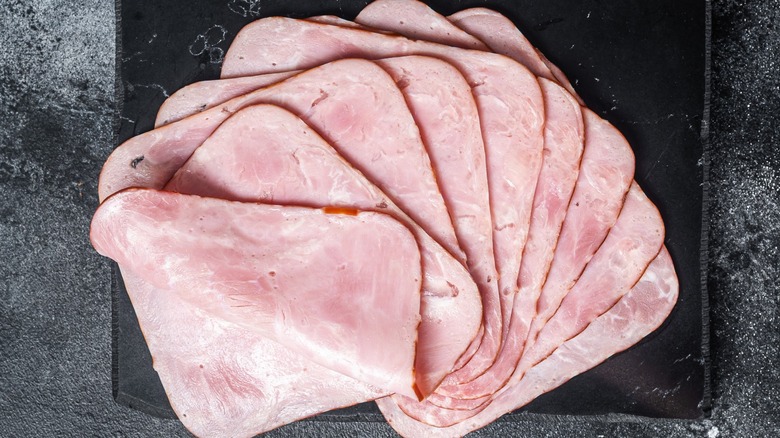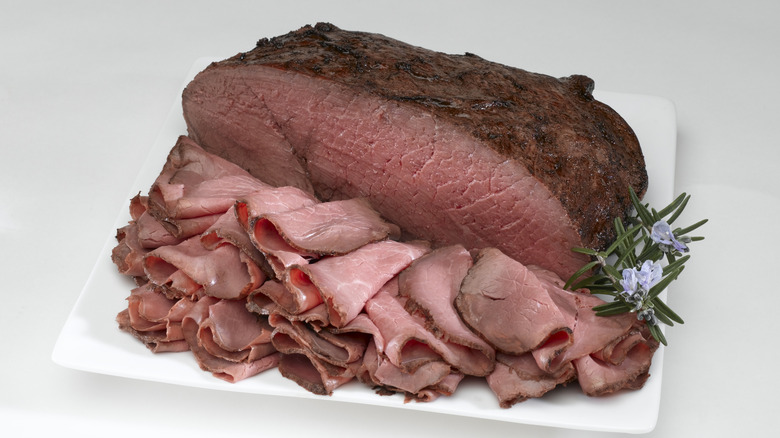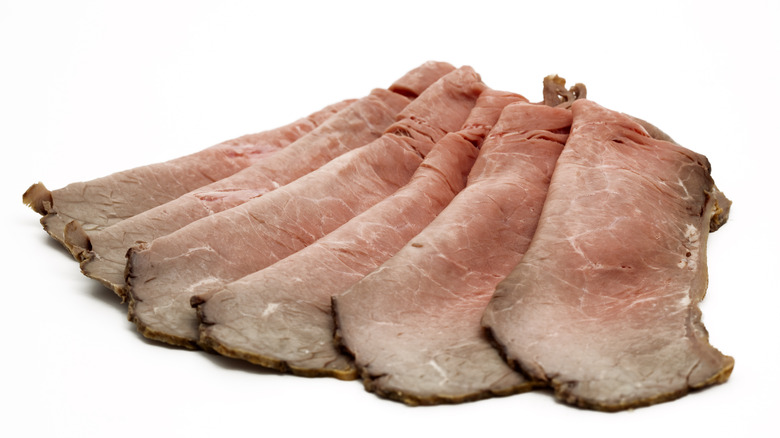Why You See Rainbow Spots On Roast Beef And Deli Meat
If you've ever opened up a package of cleanly sliced deli-style roast beef and noticed an oddly metallic, rainbow-colored sheen on the meat, don't worry. There's nothing wrong with it — the rainbow color is entirely a phenomenon caused by the way light is shining on the meat, and doesn't have anything to do with the quality of it.
The rainbow beef is more formally referred to as "iridescent" beef — and it tends to appear on beef, for reasons that'll be clear in a moment — although it's known to appear on meats like ham as well. The short scientific explanation is this: Light hits the meat and diffracts into this rainbow color due to the properties of the muscle fibers. In theory, it can occur with any type of meat (except for ground meat, since those fibers are all mashed up), but on white meats like chicken, the light color of the meat makes it effectively invisible. Darker meat is a better candidate for iridescence because the dark shade allows the reflected light to be more visible — with white meat, it's still technically there, but you just can't see it.
But why does it seem to always be deli meat?
Again, while iridescence can occur with all sorts of meats, it does seem to be oddly prevalent on those smooth-cut deli meats, like sliced roast beef. There are a few reasons for this: Number one is the ultra-smooth surface of deli meat, usually produced by a mechanical slicer. Because iridescence is caused by light hitting the meat fibers, and because deli meat is cut against the grain, exposing a lot more of those fibers, it's a prime candidate for iridescence. The smoothness of the cut also helps, since all the light will be diffracted in the same direction, making the rainbow more likely to be visible (a rougher cut will send light in more directions, making the meat rainbow less likely).
If the meat is cured (for example, pastrami), as many deli meats are, that also helps with iridescence. This is because of the phosphates in the curing process adding moisture and contributing to that ultra-smooth surface. The cut of meat may also influence iridescence, mostly because certain cuts of beef are more likely to be cut against the grain — these include top round (a common choice of meat cut for roast beef), brisket, and naval.
What to know about iridescence and safety
Sure, it may be a little unsettling to see roast beef that seems almost holographic in color, but it's nothing to worry about. Iridescence is entirely a trick of the light and isn't useful as an indicator of whether that roast beef or pastrami is safe to eat. The USDA has even backed this up. If you're worried about the safety of some cooked or cured meat that's got the rainbow shine on it, you're better off paying attention to other signs of meat spoilage like the smell of it (if it smells off, ditch it), or whether it has a sticky or slimy feel when you touch it. If there's a green tinge to the meat, it may be worth looking more closely: If the color is that metallic iridescent tone, it's likely okay, but there's the slight possibility of it being mold.
Raw meat tends not to be iridescent because of its malleable texture, so if you see shiny raw meat, look a bit closer, as there are bacteria that can cause a similar shine. If you wipe the meat and the shine goes away, it may be bacteria; if it stays, it's just iridescent. (This bacteria is more likely on raw meat rather than cooked).


